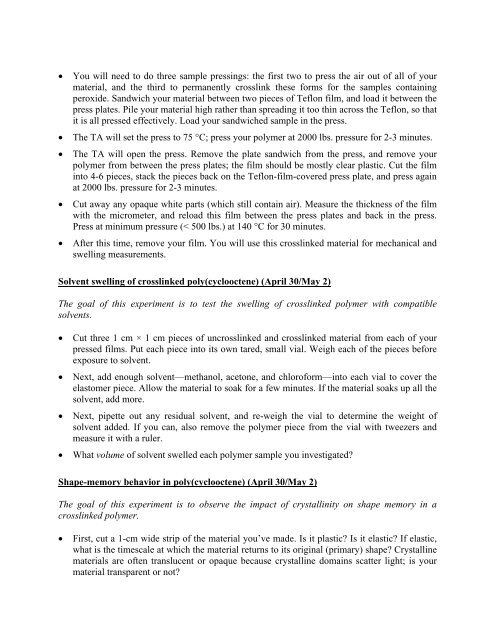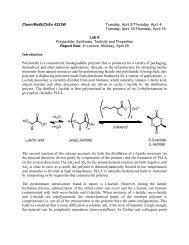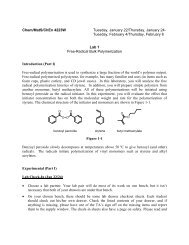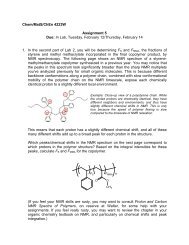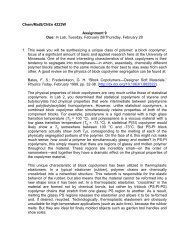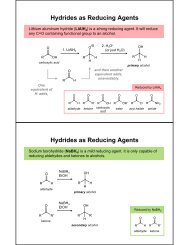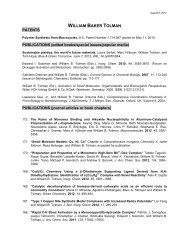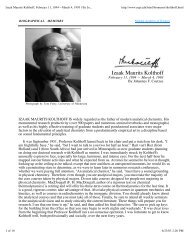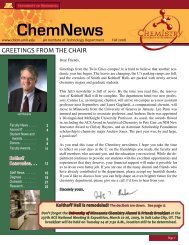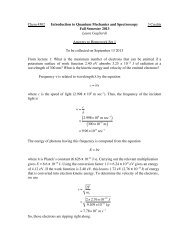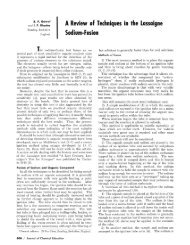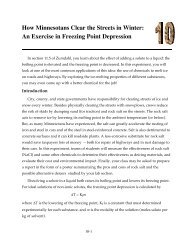Chem/MatS/ChEn 4223W Tuesday, April 23/Thursday, April 25 ...
Chem/MatS/ChEn 4223W Tuesday, April 23/Thursday, April 25 ...
Chem/MatS/ChEn 4223W Tuesday, April 23/Thursday, April 25 ...
Create successful ePaper yourself
Turn your PDF publications into a flip-book with our unique Google optimized e-Paper software.
You will need to do three sample pressings: the first two to press the air out of all of yourmaterial, and the third to permanently crosslink these forms for the samples containingperoxide. Sandwich your material between two pieces of Teflon film, and load it between thepress plates. Pile your material high rather than spreading it too thin across the Teflon, so thatit is all pressed effectively. Load your sandwiched sample in the press.The TA will set the press to 75 °C; press your polymer at 2000 lbs. pressure for 2-3 minutes.The TA will open the press. Remove the plate sandwich from the press, and remove yourpolymer from between the press plates; the film should be mostly clear plastic. Cut the filminto 4-6 pieces, stack the pieces back on the Teflon-film-covered press plate, and press againat 2000 lbs. pressure for 2-3 minutes.Cut away any opaque white parts (which still contain air). Measure the thickness of the filmwith the micrometer, and reload this film between the press plates and back in the press.Press at minimum pressure (< 500 lbs.) at 140 °C for 30 minutes.After this time, remove your film. You will use this crosslinked material for mechanical andswelling measurements.Solvent swelling of crosslinked poly(cyclooctene) (<strong>April</strong> 30/May 2)The goal of this experiment is to test the swelling of crosslinked polymer with compatiblesolvents.Cut three 1 cm × 1 cm pieces of uncrosslinked and crosslinked material from each of yourpressed films. Put each piece into its own tared, small vial. Weigh each of the pieces beforeexposure to solvent.Next, add enough solvent—methanol, acetone, and chloroform—into each vial to cover theelastomer piece. Allow the material to soak for a few minutes. If the material soaks up all thesolvent, add more.Next, pipette out any residual solvent, and re-weigh the vial to determine the weight ofsolvent added. If you can, also remove the polymer piece from the vial with tweezers andmeasure it with a ruler.What volume of solvent swelled each polymer sample you investigated?Shape-memory behavior in poly(cyclooctene) (<strong>April</strong> 30/May 2)The goal of this experiment is to observe the impact of crystallinity on shape memory in acrosslinked polymer.First, cut a 1-cm wide strip of the material you’ve made. Is it plastic? Is it elastic? If elastic,what is the timescale at which the material returns to its original (primary) shape? Crystallinematerials are often translucent or opaque because crystalline domains scatter light; is yourmaterial transparent or not?


